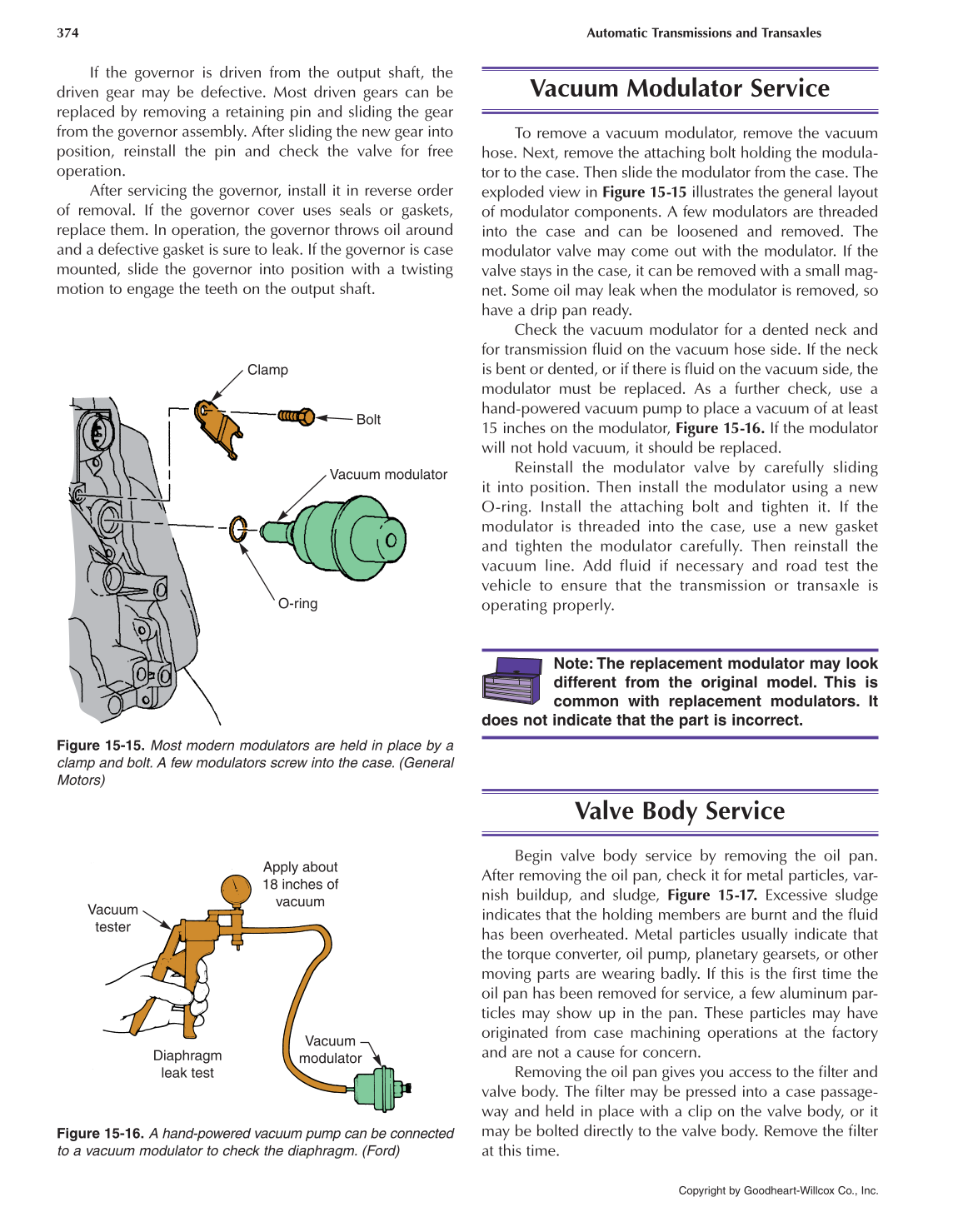Copyright by Goodheart-Willcox Co., Inc.
374 Automatic Transmissions and Transaxles
Clamp
Bolt
Vacuum modulator
O-ring
Figure 15-15. Most modern modulators are held in place by a
clamp and bolt. A few modulators screw into the case. (General
Motors)
Note: The replacement modulator may look
different from the original model. This is
common with replacement modulators. It
does not indicate that the part is incorrect.
Vacuum
tester
Apply about
18 inches of
vacuum
Vacuum
modulator
Diaphragm
leak test
Figure 15-16. A hand-powered vacuum pump can be connected
to a vacuum modulator to check the diaphragm. (Ford)
If the governor is driven from the output shaft, the
driven gear may be defective. Most driven gears can be
replaced by removing a retaining pin and sliding the gear
from the governor assembly. After sliding the new gear into
position, reinstall the pin and check the valve for free
operation.
After servicing the governor, install it in reverse order
of removal. If the governor cover uses seals or gaskets,
replace them. In operation, the governor throws oil around
and a defective gasket is sure to leak. If the governor is case
mounted, slide the governor into position with a twisting
motion to engage the teeth on the output shaft.
Vacuum Modulator Service
To remove a vacuum modulator, remove the vacuum
hose. Next, remove the attaching bolt holding the modula-
tor to the case. Then slide the modulator from the case. The
exploded view in Figure 15-15 illustrates the general layout
of modulator components. A few modulators are threaded
into the case and can be loosened and removed. The
modulator valve may come out with the modulator. If the
valve stays in the case, it can be removed with a small mag-
net. Some oil may leak when the modulator is removed, so
have a drip pan ready.
Check the vacuum modulator for a dented neck and
for transmission fluid on the vacuum hose side. If the neck
is bent or dented, or if there is fluid on the vacuum side, the
modulator must be replaced. As a further check, use a
hand-powered vacuum pump to place a vacuum of at least
15 inches on the modulator, Figure 15-16. If the modulator
will not hold vacuum, it should be replaced.
Reinstall the modulator valve by carefully sliding
it into position. Then install the modulator using a new
O-ring. Install the attaching bolt and tighten it. If the
modulator is threaded into the case, use a new gasket
and tighten the modulator carefully. Then reinstall the
vacuum line. Add fluid if necessary and road test the
vehicle to ensure that the transmission or transaxle is
operating properly.
Valve Body Service
Begin valve body service by removing the oil pan.
After removing the oil pan, check it for metal particles, var-
nish buildup, and sludge, Figure 15-17. Excessive sludge
indicates that the holding members are burnt and the fluid
has been overheated. Metal particles usually indicate that
the torque converter, oil pump, planetary gearsets, or other
moving parts are wearing badly. If this is the first time the
oil pan has been removed for service, a few aluminum par-
ticles may show up in the pan. These particles may have
originated from case machining operations at the factory
and are not a cause for concern.
Removing the oil pan gives you access to the filter and
valve body. The filter may be pressed into a case passage-
way and held in place with a clip on the valve body, or it
may be bolted directly to the valve body. Remove the filter
at this time.
